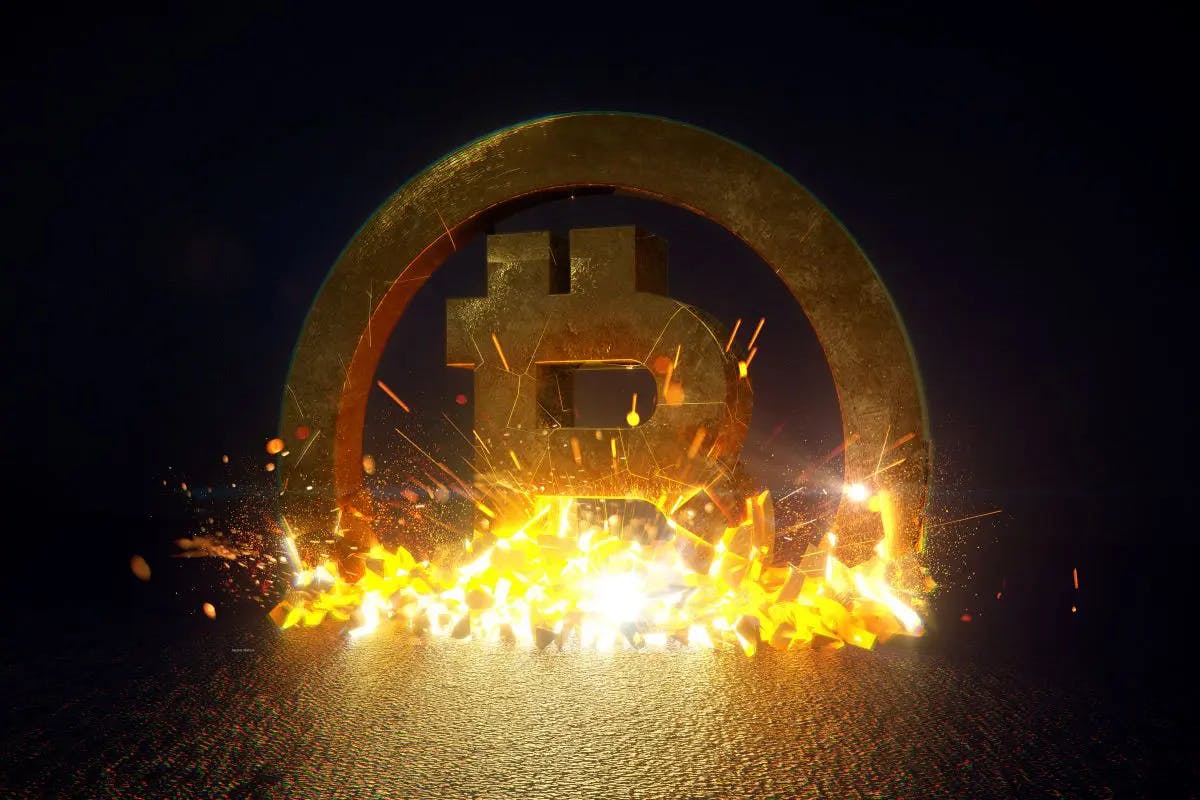Crypto Crash! 7 Times Bitcoin Survived Carnage
By Heidi Unrau | Published on 03 Jan 2023

We just witnessed a stunning crypto crash, but now what? Is Bitcoin a dead-coin walking? The veterans in this space are unphased because it’s not their first rodeo. Just like the stock market, crypto can bounce back. Bitcoin has already survived 7 crypto crashes so far, this is number eight. A 73% drop is just a flesh wound. But if you don’t know about Bitcoin’s storied past, a double-digit pullback could send you running for the hills. Here is the history of past crashes, because what doesn’t kill you makes you stronger.
Bitcoin exists because of a financial market meltdown
Bitcoin was born when $1.2 trillion US was wiped out on September 29, 2008. It was a global financial crisis where major investment banks went under, others needed government bailouts, mass layoffs plagued industries, and home foreclosures swept across America. In November of 2022, CNBC reported that over $2 trillion US has hemorrhaged from the crypto market since Bitcoin’s all-time high in 2021. The stock market roared back, and likely, crypto will too. After all, like the stock market, crypto has crashed and risen from the ashes several times.
All the times that crypto crashed and came back
At the time of writing, the price of a single Bitcoin fell from its 2021 high of just over $84,000 CAD to its current value of just over $22,700. How can anyone possibly say Bitcoin is a hedge against inflation when it lost over 70% of its value in the last year? I mean, inflation is intense right now but our loonie hasn’t even lost half its value from last year. What gives?
Shortly after Bitcoin was created, it began trading at just a fraction of a penny. As Cointelegraph pointed out, the price of Bitcoin has had a compound annual growth rate (CAGR) of 196.7% in the last 10 years. That means Bitcoin has had a 5,200,000% return since launch. That takes into account all of its market crashes. Compare that to the S&P Index 10-year average annual return of 13.6%, and that’s with all of the tech unicorns we all remember. So, let’s do a little time travelling. This isn’t the first crypto crash, and certainly not the worst.
Crypto crash #1: June 2011 99.99%
The first cut is the deepest. In June of 2011, the price of Bitcoin basically fell 100%. What caused such a dramatic crypto crash? The world’s biggest crypto exchange at the time suffered a devastating hack. Hundreds of people on Mt Gox, a name now synonymous with pain and misery, had their accounts hacked and their Bitcoin stolen. Why?
The price of Bitcoin had recently gone parabolic, rocketing from $2 US to an all-time high of $32, then finding support around $17.50 just before the hack. That kind of price activity made Bitcoin the shiniest diamond in the jewellery store. The hack triggered panic and in just one day, the price of Bitcoin plummeted from $17.50 US to just a penny. Ouch!
Crypto crash #2: August 2012 56%
After the 2011 hack, the price of Bitcoin climbed its way from about a penny to just over $15 US by August 2012. But the previous bloodbath attracted more predators. Now the market was teeming with scammers a-plenty. One such scammer was Trendon Shavors. He was behind Bitcoin Savings and Trust, a crypto investment fund that promised guaranteed returns of 7% per week. If that wasn’t the first clue to run the other way, he also went by the internet handle “Pirate”. I kid you not.
He swindled starry-eyed investors out of 700,000 Bitcoin and used it to bankroll his lavish lifestyle. What triggered the crypto crash? The Ponzi scheme ran out of new members. When he couldn’t make good on those ridiculous returns, he defaulted. The price of Bitcoin crashed almost 40% within minutes and kept falling over the next few days. It finally bottomed out at $7.50 US, down from $15.
Crash #3: April 2013 83%
But crypto investors are nothing if not bulletproof. Even after two major hits within a year, Bitcoiners were back to filling their bags once again. By April 2013, the price of Bitcoin had risen from the ashes to break a new all-time high over $260 US. Bitcoin landed on the radar of mainstream media, triggering a sense of FOMO (fear of missing out) among soon-to-be Bitcoiners.
What triggered the crypto crash? A Bitcoin bull run broke out into a stampede on Mt Gox. They couldn’t keep up with the trade volume, and the exchange glitched with outages. Now there was blood in the water, signalling hackers to swarm and attack Mt Gox while it was weak. Hackers hit Mt Gox with Denial of Service (DoS) attacks that kept people from connecting to the network. The debauchery caused the price of Bitcoin to plummet over 80% from $260 US to around $50.
Crypto crash #4: December 2013 50%
The Mt Gox fiasco was a nightmare and the exchange is now defunct, but it wasn’t lights-out for Bitcoin. The price rebounded from the 2013 April crypto crash and hit a new all-time high of almost $1,200 US just 8 months later; faster than it takes to make a new human from scratch. In fact, Bitcoin skyrocketed from just $200 US at the beginning of November to about $1,250 by December 3rd.
It seemed like money printing season, everyone was rolling in profits. So what triggered this crypto crash? China showed up and said, “hold my beer.” Concerned that Bitcoin was not backed by a central bank, and high risk for money laundering, China announced a ban on crypto. Within two weeks, the price of Bitcoin fell by around 50%. Only this time, the climb back up would be longer and harder. The price of Bitcoin remained choppy for about 4 years.
Crypto crash #5: December 2017 83%
Probably the best Bitcoin Bull Run to date happened in 2017. That year, the chilly bear market warmed up when Bitcoin rallied and broke its previous all-time high. The price skyrocketed from around $200 US to almost $20,000. At the same time, Ethereum (ETH) had made a name for itself as the second-largest crypto by market cap. Alternative coins (altcoins) and new crypto projects went wild. FOMO prompted many to cash in their ETH to jump on Initial Coin Offerings (ICOs). Again, money printing was in full swing, coining the term “Alt Season.”
So why did crypto crash this time? The market hysteria signalled a bubble, which likely triggered savvy investors to start pulling profits. After breaking a new all-time high on December 15, 2017, the trend reversed when the price of Bitcoin started dipping. It fell 30% over the next several days. By December 2018, the price of Bitcoin had fallen over 80%. Crypto entered a brutal bear market that lasted about 2 years thanks to anti-crypto government sentiment, hacks on exchanges in Asia, elaborate crypto scams like QuadrigaCX, and whisperings of another China crypto ban.
Crash #6: March 2020 50%
The onset of the Pandemic triggered global anxiety that rocked all financial markets, including crypto. This time, lockdowns, layoffs, and supply chain issues triggered both a stock market pullback and a crypto crash. But crypto crashed particularly hard because people cashed out their more risky, speculative assets in favour of emergency money amid economic turbulence.
Within 24-hours, the price of Bitcoin fell almost 40% and continued to fall over the next few days. But it was just a flash crash. Bitcoin bottomed out around March 16th and immediately began to rally, reaching its pre-crash price the following month.
Crypto market crash #7: May 2021 50%
By 2021, not only had Bitcoin been making headlines for a while, but by this time, Bitcoin had converted major institutional investors, including finance heavyweight, Kevin O’Leary, who had previously called crypto “a big nothing burger.” Tesla and MicroStrategy led the way, purchasing large Bitcoin positions. Elon Musk announced Tesla would start accepting Bitcoin payments for cars. Others like Greyscale, Blackrock, and Ark Invest also became bullish on Bitcoin, and Canada launched the world’s first Bitcoin Exchange-Traded Fund (ETF). Heck, El Salvador made Bitcoin legal tender.
There was euphoria in the crypto space when Bitcoin hit a new all-time high of $64,000 US in April 2021. Then Musk entered the chat with a series of tweets that triggered yet another crypto crash. He walked back on his position to accept Bitcoin as payment for a Tesla, criticizing Bitcoin as an environmentally dirty asset. Suddenly, Bitcoin went from digital gold to digital coal. Then China announced another crypto ban. Fear, uncertainty and doubt (FUD) went viral, triggering the price of Bitcoin to crash over 50% by the end of June.
Crypto crash #8: what happened this time?
What happened on May 7, 2022, was just another day in crypto. What triggered it though, is worthy of some shock and awe. Over $200 billion US was wiped from the crypto market after TerraUST, a prominent stablecoin, lost its peg to the US Dollar. If history has taught us anything, it’s that Bitcoin will likely recover. What about the altcoins? Well, that remains to be seen.
The crypto market has been buckling under the pressure of public anxiety for quite some time. But let’s be clear, so have the traditional financial markets. Between the invasion of Ukraine, budget-busting inflation, a global housing crisis, and systemic interest rate hikes, it’s a lot to process. It would be weird if we didn’t see investors cashing in their riskier assets when major financial news is negative. The crypto market has weakened but it will recover.
